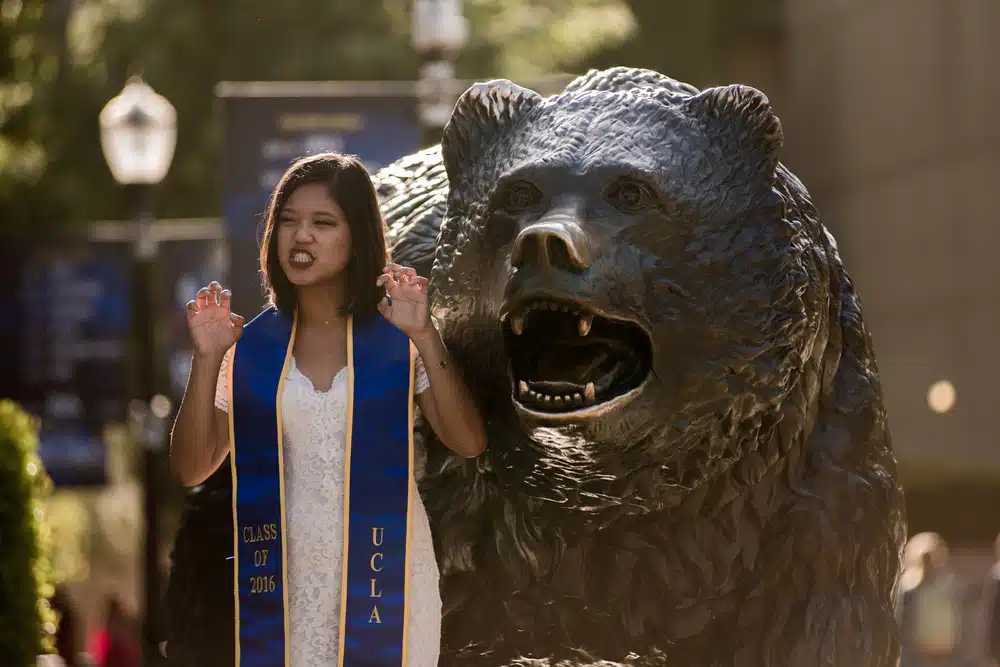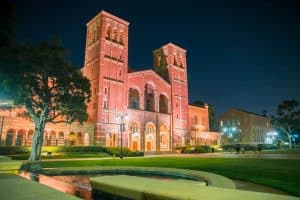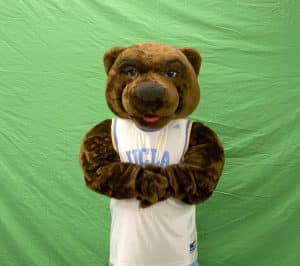UCLA’s Official Mascot
Meet Joe Bruin, UCLA’s official mascot, a symbol of pride, unity, and spirit for the University of California, Los Angeles. Joe Bruin is not just a character; he embodies the university’s values. Joe Bruin is a friendly face at sporting events and is a beloved figure on campus.
With his distinctive blue and gold attire, Joe Bruin represents UCLA’s vibrant culture and tradition. Whether cheering on the Bruins at a football game or participating in community events, Joe Bruin’s presence is a constant reminder of the camaraderie and excellence that define UCLA. His lively personality and engaging antics have made him a favorite among students, faculty, alumni, and fans.
Historical Background: The creation and evolution of Joe Bruin
The story of Joe Bruin, UCLA’s official mascot, dates back to the early 1920s. Initially, the university’s teams were known as the “Cubs,” reflecting their connection to the University of California, Berkeley’s “Bears.”
However, a new mascot was needed as UCLA sought to establish its unique identity. In 1924, students voted to adopt the bear as their mascot, and Joe Bruin was born. Over the years, Joe Bruin’s appearance and character have evolved, reflecting changes in fashion, culture, and the university’s growth.
From a more ferocious bear to the friendly and approachable figure we know today, Joe Bruin’s transformation is a testament to UCLA’s dynamic spirit and continuous innovation.
Significance: Why Joe Bruin is an essential symbol for UCLA
Joe Bruin is more than UCLA’s official mascot; he’s a unifying symbol transcending generations and backgrounds. His significance lies in his ability to unite people, fostering a sense of belonging and pride in being part of the UCLA community.
Whether it’s the excitement he brings to athletic events or his role in promoting university initiatives, Joe Bruin’s impact is felt across all aspects of campus life. His presence is a constant reminder of UCLA’s commitment to excellence, inclusivity, and community engagement.
Through his actions and interactions, Joe Bruin embodies the values that make UCLA one of the nation’s leading institutions, reinforcing the bond between students, faculty, alumni, and the broader community.
His role as UCLA’s official mascot is not merely ceremonial; it’s a living representation of what it means to be a Bruin.
What Makes Joe Bruin Unique?
What sets Joe Bruin apart as UCLA’s official mascot is his appearance and the essence of what he represents. Joe Bruin symbolizes resilience, excellence, and community spirit that resonates with everyone connected to UCLA.
He’s a friend, a cheerleader, and a constant reminder of the pride and unity that define the UCLA community.
Physical Appearance: Description of Joe Bruin’s distinctive features
Joe Bruin, UCLA’s official mascot, is instantly recognizable by his distinctive features. Dressed in UCLA’s iconic blue and gold, he sports a friendly smile that radiates warmth and approachability.
His robust bear figure, complete with a solid yet gentle expression, makes him both imposing and endearing. Joe’s attire often includes a jersey or letterman jacket adorned with the university’s logo, and his playful accessories vary depending on the occasion.
His physical appearance is carefully crafted to reflect the strength and the welcoming nature of UCLA, making him a beloved figure not just on campus but across the nation.
Personality Traits: The character and behavior that define Joe Bruin
The character and behavior that define Joe Bruin go far beyond his physical appearance. As UCLA’s official mascot, Joe’s personality is a blend of enthusiasm, kindness, and a touch of mischievous charm.
He’s energetic and engaging, always ready to cheer on the Bruins or join a celebratory dance. But Joe’s character is also marked by dignity and respect, reflecting the university’s commitment to excellence and integrity.
Whether interacting with fans, posing for photos, or participating in community outreach, Joe Bruin’s behavior is a testament to the values that UCLA holds dear. His personality entertains and inspires, making him a truly unique and cherished symbol of the university.
Representation: How Joe Bruin embodies the spirit of UCLA
Joe Bruin’s role as UCLA’s official mascot is not merely about appearance or entertainment; it’s about embodying the spirit of UCLA. He represents the ambition, diversity, and community at the heart of the university’s mission.
Through his actions and interactions, Joe Bruin brings to life the principles that guide UCLA, fostering a sense of connection and pride among students, faculty, alumni, and fans. He’s not just a mascot; he’s a reflection of the university’s identity, a living symbol of what it means to be part of the UCLA family.
Joe Bruin’s representation goes beyond the superficial, making him an essential and enduring part of the UCLA experience.
What are actual Bruin values?
The True Bruin declaration of community standards has been accepted as a recommendation for action by the campus. The concept of what it means to be a True Bruin may be applied to every member of the UCLA community, including students, staff members, faculty members, and alumni.
UCLA’s official mascot Joe Bruin is encouraging new members of the UCLA community that they will conduct themselves in the way outlined in the True Bruin statement.
UCLA True Bruin
Bruins commit themselves to the following highest ethical standards:
Integrity
I will conduct myself with integrity in my dealings with & on behalf of the University.
Excellence
I will conscientiously strive for excellence in my work.
Accountability
I will be accountable as an individual and member of this community for my ethical conduct.
Respect
I will respect the rights and dignity of others.
Service
I will make an impact on our global community through public service.
What are the colors of UCLA?
Blue and gold are the colors that represent UCLA, just as they do for the University of California.
The institution’s colors were chosen to symbolize numerous aspects of the state, including but not limited to the following: The color blue represents the sea and the natural flora. Yellow symbolizes California, the California poppy, and the state’s famous sunsets.
Throughout the years, there has undoubtedly been a shift in tone. The blue, for example, has gone through several iterations, including powder, sky, and royal.
Where Can You Find Joe Bruin?
Where can you find Joe Bruin, UCLA’s official mascot? The answer is almost everywhere, the UCLA spirit thrives. Joe Bruin is ubiquitous on campus, at sporting events, community gatherings, and even in the virtual world.
Sporting Events: Joe Bruin’s presence at UCLA’s athletic competitions
At UCLA’s athletic competitions, Joe Bruin’s presence is a highlight that adds excitement and energy to the games. As UCLA’s official mascot, Joe is there to cheer on the Bruins, whether it’s football, basketball, or any other sport.
His enthusiastic support, playful interactions with fans, and spirited dance moves are vital to the game-day experience. Joe Bruin’s role goes beyond mere entertainment; he’s a symbol of unity and pride, rallying the crowd and creating a sense of camaraderie among fans.
His presence at sporting events is a cherished tradition that embodies the passion and excellence of UCLA athletics.
Campus Life: Locations and events where Joe Bruin makes regular appearances
Beyond the athletic fields, Joe Bruin, UCLA’s official mascot, is a familiar face in various locations and events across campus. From welcoming new students during orientation to celebrating milestones at graduation ceremonies, Joe’s presence adds a touch of joy and unity to campus life.
He’s often seen at festivals, fundraisers, and community outreach programs, engaging with students and promoting the university’s values. Joe Bruin’s regular appearances at these events reflect UCLA’s commitment to community engagement, inclusivity, and academic excellence, making him an integral part of the university’s culture.
Virtual Presence: Joe Bruin’s representation in digital media and online platforms
In today’s digital age, Joe Bruin’s influence extends beyond physical appearances. As UCLA’s official mascot, Joe has a significant virtual presence, connecting with fans and followers through social media, websites, and online campaigns.
Whether sharing updates, participating in virtual events, or engaging with audiences through interactive content, Joe Bruin’s online representation is a testament to UCLA’s adaptability and innovation.
His virtual presence allows him to reach a broader audience, fostering a sense of connection and pride among Bruins worldwide. Joe Bruin’s digital persona continues to evolve, reflecting the university’s commitment to staying connected and relevant in an ever-changing world.
Why Does Joe Bruin Matter to UCLA’s Community?
The answer lies in his multifaceted role as UCLA’s official mascot, a symbol that goes beyond mere entertainment. He’s more than a mascot; he represents UCLA’s commitment to excellence, community engagement, and diversity.
Symbol of Unity
As a symbol of unity, Joe Bruin plays a vital role in fostering a sense of belonging among students and alumni. UCLA’s official mascot is a common thread that connects people from various backgrounds, disciplines, and generations.
His presence at games, events, and ceremonies creates a shared experience that transcends individual differences. Joe Bruin’s ability to unite people and create a sense of family and pride is a testament to the university’s emphasis on community and collaboration.
He’s not just a figure to cheer for; he’s a symbol that resonates with everyone connected to UCLA, reinforcing the bond that makes the university a unique and supportive environment.
Inspirational Role
Joe Bruin’s inspirational role goes beyond his lively antics and engaging personality. As UCLA’s official mascot, he’s a source of motivation and energy that uplifts the UCLA community.
Whether it’s rallying the crowd at a crucial game or encouraging participation in university initiatives, Joe Bruin’s presence adds a spark of enthusiasm that inspires action. His ability to energize the community reflects the passion and ambition at the core of UCLA’s mission.
Joe Bruin’s impact is not just about entertainment; it’s about inspiring people to strive for excellence, to be part of something greater, and to embrace the spirit of being a Bruin.
Inclusivity
Inclusivity is a cornerstone of UCLA’s values, and Joe Bruin plays a significant role in promoting diversity and acceptance within the university. As UCLA’s official mascot, Joe represents all Bruins, regardless of background, ethnicity, or beliefs.
His presence at various events and interactions with students and faculty emphasizes the university’s commitment to creating an inclusive environment. Joe Bruin’s role in promoting diversity is not just symbolic; it’s an active part of UCLA’s efforts to ensure that everyone feels welcome and valued.
His ability to connect with people from different walks of life reflects the university’s dedication to fostering a community that celebrates diversity and embraces acceptance.
How Can You Become Part of Joe Bruin’s Legacy?
Becoming part of Joe Bruin’s legacy is an opportunity open to all who connect with UCLA’s spirit and values. As UCLA’s official mascot, Joe Bruin represents more than just a character; he embodies a tradition passed down through generations.
Everyone can play a role in continuing Joe Bruin’s legacy. It’s about embracing the values that Joe represents and actively participating in the university’s culture and traditions.
Opportunities to Interact
Meeting and engaging with Joe Bruin is a highlight for many students, alumni, and fans. As UCLA’s official mascot, Joe’s presence at games, festivals, and community events offers numerous opportunities for interaction.
Whether taking a selfie, joining in a dance, or simply sharing a high-five, Joe Bruin’s approachable and lively personality makes every encounter memorable. These interactions are not just fun; they’re a way to connect with UCLA’s spirit and become part of a shared experience.
Joe Bruin’s ability to engage with people from all walks of life reflects the university’s emphasis on community and connection, making every interaction a meaningful part of the UCLA experience.
Community Involvement
Joe Bruin’s legacy is not just about the mascot itself; it’s about the community’s involvement and contribution. Students and alumni can actively contribute to Joe Bruin’s legacy through various means.
Whether it’s supporting Joe at games, participating in events where Joe is present, or even contributing ideas and feedback to enhance Joe’s role, community involvement is critical. As UCLA’s official mascot, Joe Bruin’s impact is shaped by the collective efforts of the university’s community.
Volunteering, engaging with Joe’s social media channels, or simply embracing the spirit that Joe represents are ways to be part of this enduring legacy. Joe Bruin’s legacy is a shared journey, reflecting the university’s commitment to collaboration, engagement, and the continuous celebration of what it means to be a Bruin.
Future Prospects: Potential developments and what the future may hold for Joe Bruin
As UCLA continues to evolve and innovate, so does Joe Bruin, UCLA’s official mascot. The future holds exciting prospects for Joe, with potential developments that reflect the university’s commitment to staying relevant and connected.
The possibilities are endless, whether it’s enhancing Joe’s virtual presence, expanding his role in community outreach, or exploring new ways to engage with fans. Joe Bruin’s adaptability and continuous evolution reflect UCLA’s dynamic spirit and forward-thinking approach.
The future of Joe Bruin is not just about maintaining a tradition; it’s about embracing change and innovation while staying true to the values that define what it means to be a Bruin. Joe Bruin’s future is a promising and inspiring journey that continues to resonate with the UCLA community and beyond.
Conclusion
From his distinctive appearance to his engaging personality, Joe Bruin’s role transcends entertainment, fostering a sense of unity, inspiration, and pride among students, alumni, and fans. His legacy is a shared journey shaped by the collective efforts of the UCLA community.
Joe Bruin’s impact as UCLA’s official mascot is a testament to the university’s unique identity and enduring values, making him an essential and cherished part of the UCLA experience.
Experience UCLA school spirit with Joe Bruin
Suppose you want to increase your chances of getting into UCLA. In that case, you might think about getting advice from professionals specializing in college admissions and working for companies like AdmissionSight.
AdmissionSight has earned its reputation as the go-to resource for professional guidance on applying to and being accepted by colleges due to its more than a decade of experience assisting students just like you in gaining admission to their schools of first and second choice.
Please do not hesitate to get in touch with us if you are interested in setting up an initial consultation that will not incur any costs.










































